cruise control BMW 535I XDRIVE 2013 Owners Manual
[x] Cancel search | Manufacturer: BMW, Model Year: 2013, Model line: 535I XDRIVE, Model: BMW 535I XDRIVE 2013Pages: 246, PDF Size: 5.39 MB
Page 13 of 246
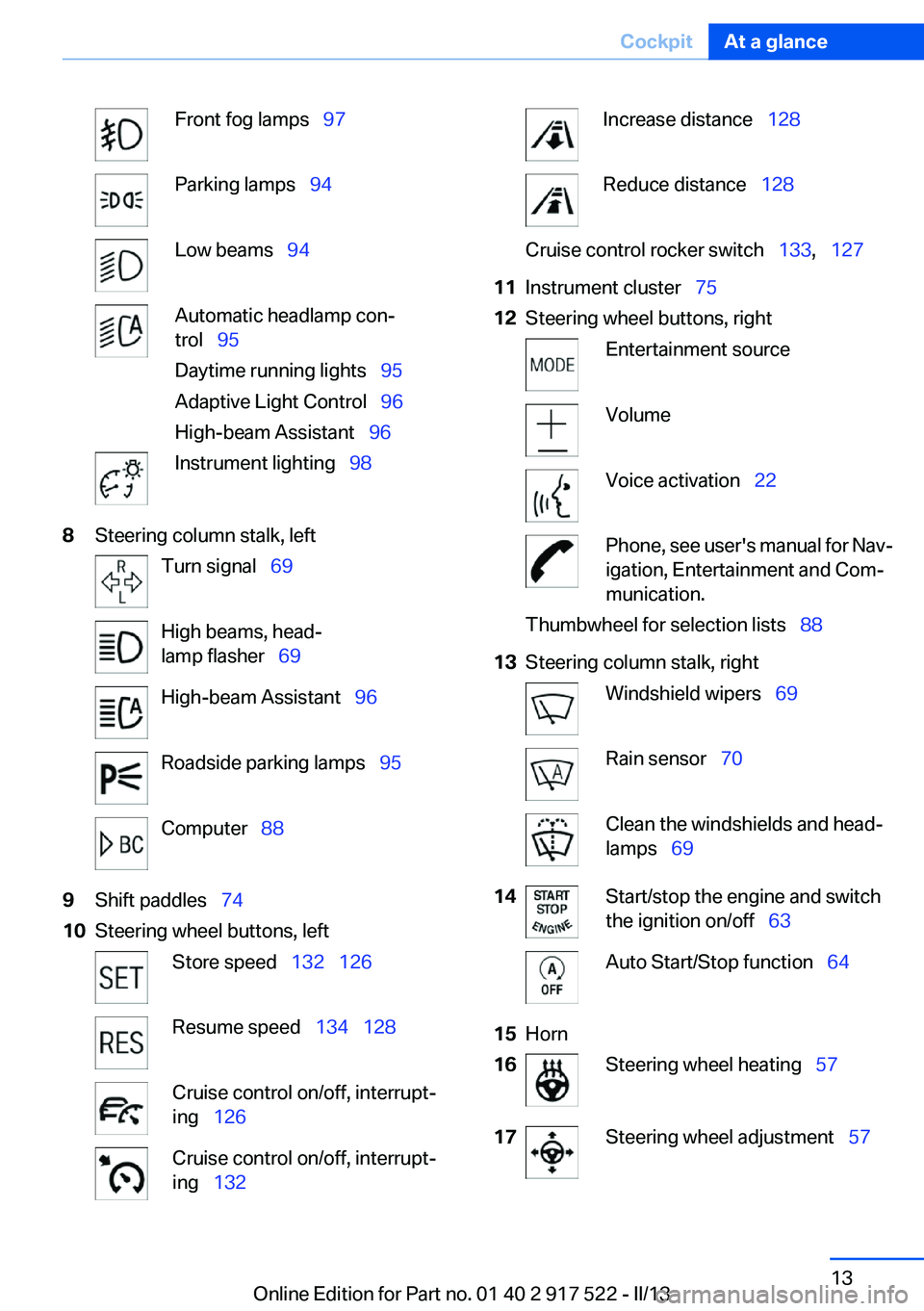
Front fog lamps‚Äā‚ÄÖ97Parking lamps‚Äā‚ÄÖ94Low beams‚Äā‚ÄÖ94Automatic headlamp con‚Äź
trol‚Äā‚ÄÖ 95
Daytime running lights‚Äā‚ÄÖ 95
Adaptive Light Control‚Äā‚ÄÖ 96
High-beam Assistant‚Äā‚ÄÖ 96Instrument lighting‚Äā‚ÄÖ988Steering column stalk, leftTurn signal‚Äā‚ÄÖ69High beams, head‚Äź
lamp flasher‚Äā‚ÄÖ 69High-beam Assistant‚Äā‚ÄÖ 96Roadside parking lamps‚Äā‚ÄÖ 95Computer‚Äā‚ÄÖ889Shift paddles‚Äā‚ÄÖ 7410Steering wheel buttons, leftStore speed‚Äā‚ÄÖ132‚Äā‚ÄÖ126Resume speed‚Äā‚ÄÖ 134‚Äā‚ÄÖ128Cruise control on/off, interrupt‚Äź
ing‚Äā‚ÄÖ 126Cruise control on/off, interrupt‚Äź
ing‚Äā‚ÄÖ 132Increase distance‚Äā‚ÄÖ 128Reduce distance‚Äā‚ÄÖ128Cruise control rocker switch‚Äā‚ÄÖ 133,‚Äā‚ÄÖ12711Instrument cluster‚Äā‚ÄÖ 7512Steering wheel buttons, rightEntertainment sourceVolumeVoice activation‚Äā‚ÄÖ22Phone, see user's manual for Nav‚Äź
igation, Entertainment and Com‚Äź
munication.Thumbwheel for selection lists‚Äā‚ÄÖ 8813Steering column stalk, rightWindshield wipers‚Äā‚ÄÖ69Rain sensor‚Äā‚ÄÖ70Clean the windshields and head‚Äź
lamps‚Äā‚ÄÖ 6914Start/stop the engine and switch
the ignition on/off‚Äā‚ÄÖ 63Auto Start/Stop function‚Äā‚ÄÖ 6415Horn16Steering wheel heating‚Äā‚ÄÖ5717Steering wheel adjustment‚Äā‚ÄÖ 57Seite 13CockpitAt a glance13
Online Edition for Part no. 01 40 2 917 522 - II/13
Page 33 of 246
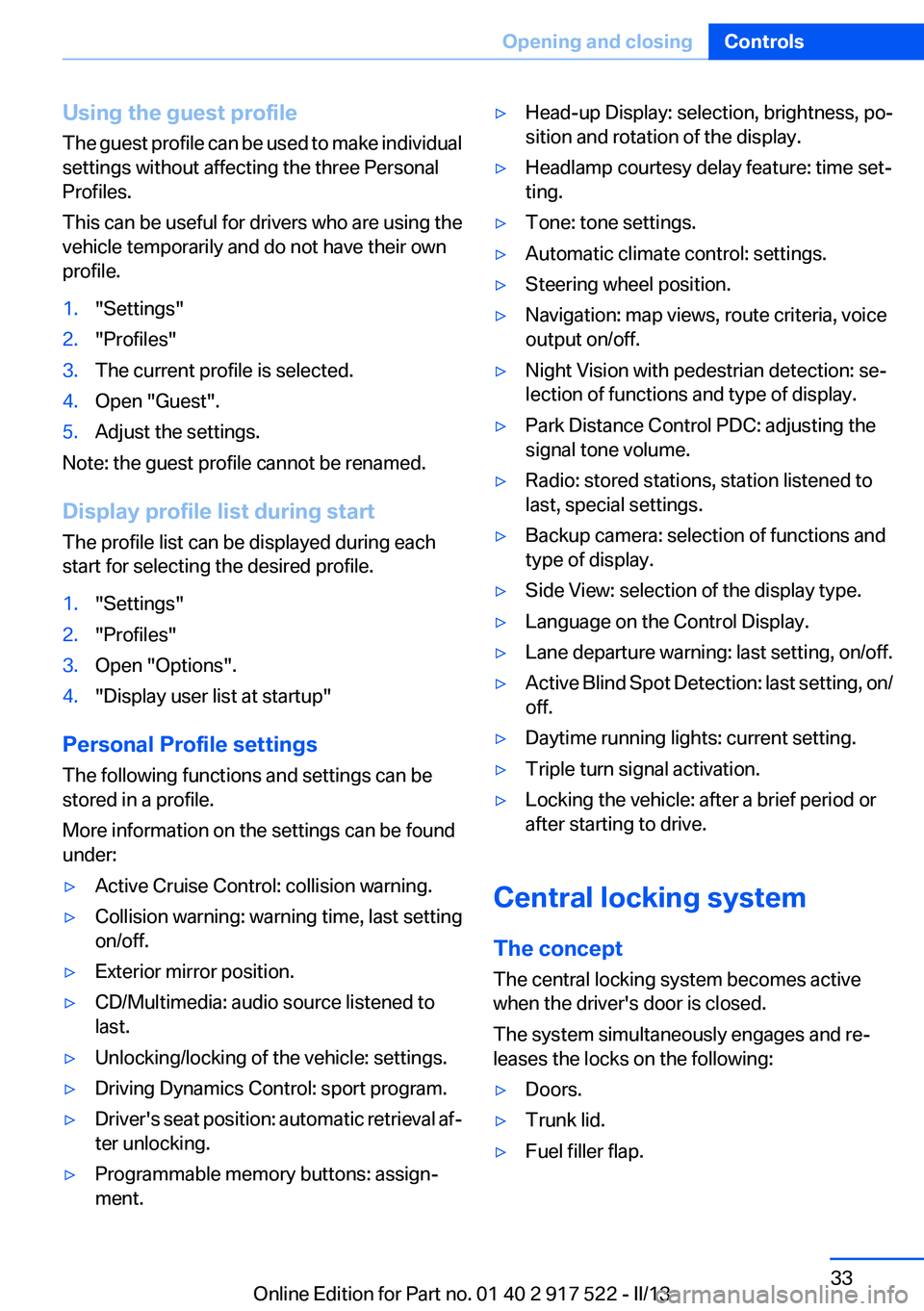
Using the guest profile
The guest profile can be used to make individual
settings without affecting the three Personal
Profiles.
This can be useful for drivers who are using the
vehicle temporarily and do not have their own
profile.1."Settings"2."Profiles"3.The current profile is selected.4.Open "Guest".5.Adjust the settings.
Note: the guest profile cannot be renamed.
Display profile list during start
The profile list can be displayed during each
start for selecting the desired profile.
1."Settings"2."Profiles"3.Open "Options".4."Display user list at startup"
Personal Profile settings
The following functions and settings can be
stored in a profile.
More information on the settings can be found
under:
‚Ė∑Active Cruise Control: collision warning.‚Ė∑Collision warning: warning time, last setting
on/off.‚Ė∑Exterior mirror position.‚Ė∑CD/Multimedia: audio source listened to
last.‚Ė∑Unlocking/locking of the vehicle: settings.‚Ė∑Driving Dynamics Control: sport program.‚Ė∑Driver's seat position: automatic retrieval af‚Äź
ter unlocking.‚Ė∑Programmable memory buttons: assign‚Äź
ment.‚Ė∑Head-up Display: selection, brightness, po‚Äź
sition and rotation of the display.‚Ė∑Headlamp courtesy delay feature: time set‚Äź
ting.‚Ė∑Tone: tone settings.‚Ė∑Automatic climate control: settings.‚Ė∑Steering wheel position.‚Ė∑Navigation: map views, route criteria, voice
output on/off.‚Ė∑Night Vision with pedestrian detection: se‚Äź
lection of functions and type of display.‚Ė∑Park Distance Control PDC: adjusting the
signal tone volume.‚Ė∑Radio: stored stations, station listened to
last, special settings.‚Ė∑Backup camera: selection of functions and
type of display.‚Ė∑Side View: selection of the display type.‚Ė∑Language on the Control Display.‚Ė∑Lane departure warning: last setting, on/off.‚Ė∑Active Blind Spot Detection: last setting, on/
off.‚Ė∑Daytime running lights: current setting.‚Ė∑Triple turn signal activation.‚Ė∑Locking the vehicle: after a brief period or
after starting to drive.
Central locking system
The concept
The central locking system becomes active
when the driver's door is closed.
The system simultaneously engages and re‚Äź
leases the locks on the following:
‚Ė∑Doors.‚Ė∑Trunk lid.‚Ė∑Fuel filler flap.Seite 33Opening and closingControls33
Online Edition for Part no. 01 40 2 917 522 - II/13
Page 82 of 246
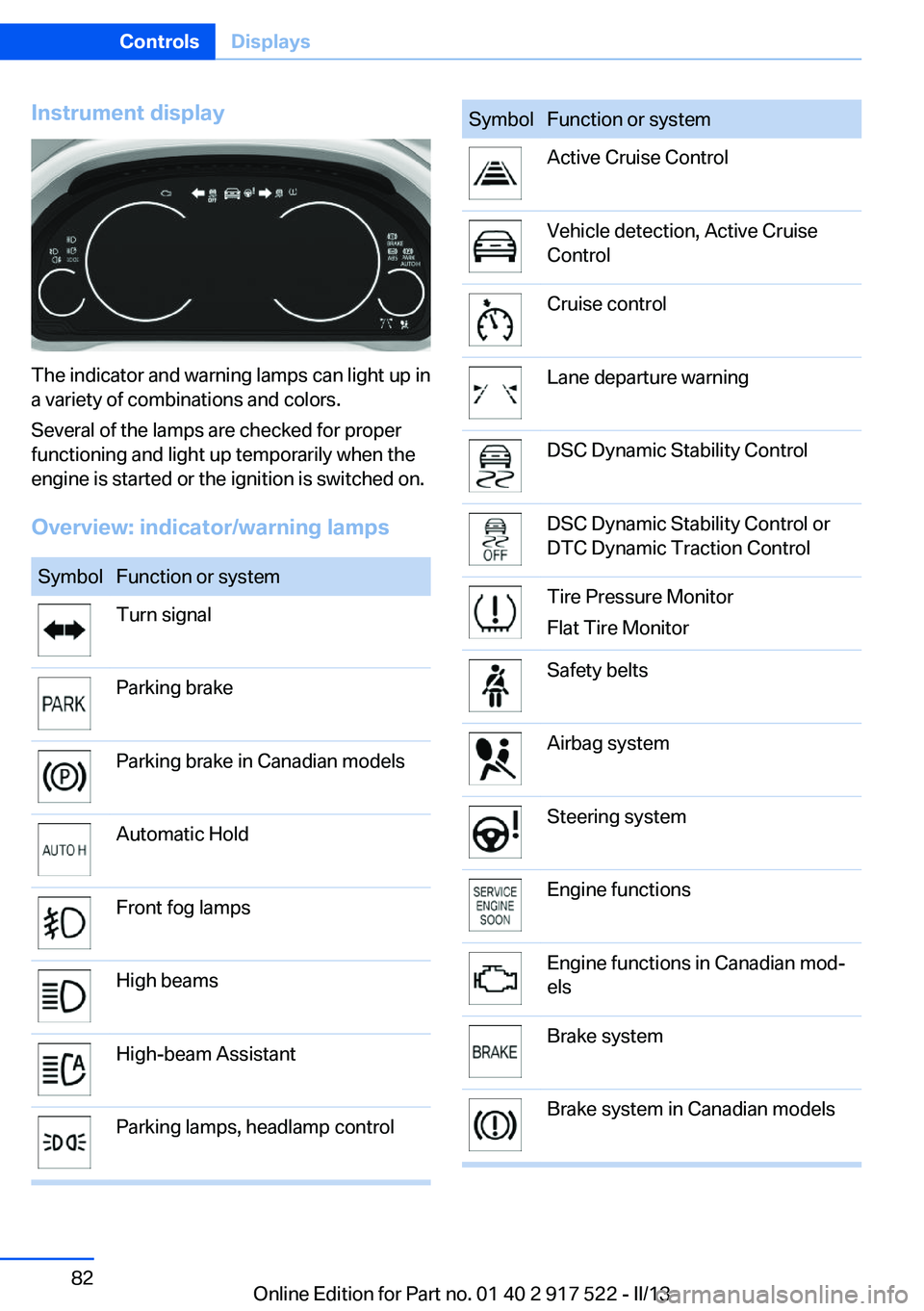
Instrument display
The indicator and warning lamps can light up in
a variety of combinations and colors.
Several of the lamps are checked for proper
functioning and light up temporarily when the
engine is started or the ignition is switched on.
Overview: indicator/warning lamps
SymbolFunction or systemTurn signalParking brakeParking brake in Canadian modelsAutomatic HoldFront fog lampsHigh beamsHigh-beam AssistantParking lamps, headlamp controlSymbolFunction or systemActive Cruise ControlVehicle detection, Active Cruise
ControlCruise controlLane departure warningDSC Dynamic Stability ControlDSC Dynamic Stability Control or
DTC Dynamic Traction ControlTire Pressure Monitor
Flat Tire MonitorSafety beltsAirbag systemSteering systemEngine functionsEngine functions in Canadian mod‚Äź
elsBrake systemBrake system in Canadian modelsSeite 82ControlsDisplays82
Online Edition for Part no. 01 40 2 917 522 - II/13
Page 107 of 246
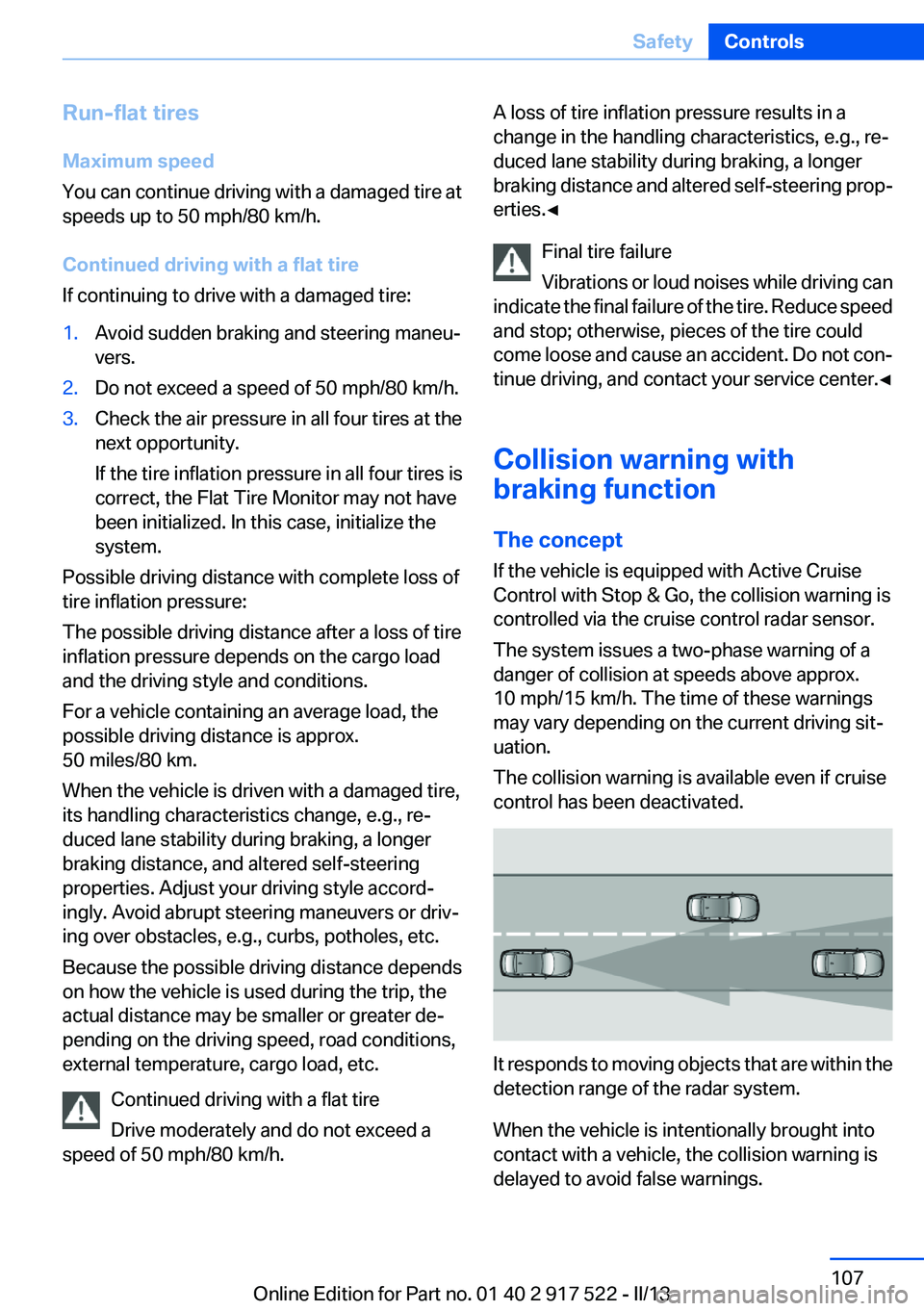
Run-flat tires
Maximum speed
You can continue driving with a damaged tire at
speeds up to 50 mph/80 km/h.
Continued driving with a flat tire
If continuing to drive with a damaged tire:1.Avoid sudden braking and steering maneu‚Äź
vers.2.Do not exceed a speed of 50 mph/80 km/h.3.Check the air pressure in all four tires at the
next opportunity.
If the tire inflation pressure in all four tires is
correct, the Flat Tire Monitor may not have
been initialized. In this case, initialize the
system.
Possible driving distance with complete loss of
tire inflation pressure:
The possible driving distance after a loss of tire
inflation pressure depends on the cargo load
and the driving style and conditions.
For a vehicle containing an average load, the
possible driving distance is approx.
50 miles/80 km.
When the vehicle is driven with a damaged tire,
its handling characteristics change, e.g., re‚Äź
duced lane stability during braking, a longer
braking distance, and altered self-steering
properties. Adjust your driving style accord‚Äź
ingly. Avoid abrupt steering maneuvers or driv‚Äź
ing over obstacles, e.g., curbs, potholes, etc.
Because the possible driving distance depends
on how the vehicle is used during the trip, the
actual distance may be smaller or greater de‚Äź
pending on the driving speed, road conditions,
external temperature, cargo load, etc.
Continued driving with a flat tire
Drive moderately and do not exceed a
speed of 50 mph/80 km/h.
A loss of tire inflation pressure results in a
change in the handling characteristics, e.g., re‚Äź
duced lane stability during braking, a longer
braking distance and altered self-steering prop‚Äź
erties.‚óÄ
Final tire failure
Vibrations or loud noises while driving can
indicate the final failure of the tire. Reduce speed
and stop; otherwise, pieces of the tire could
come loose and cause an accident. Do not con‚Äź
tinue driving, and contact your service center. ‚óÄ
Collision warning with
braking function
The concept
If the vehicle is equipped with Active Cruise
Control with Stop & Go, the collision warning is
controlled via the cruise control radar sensor.
The system issues a two-phase warning of a
danger of collision at speeds above approx.
10 mph/15 km/h. The time of these warnings
may vary depending on the current driving sit‚Äź
uation.
The collision warning is available even if cruise
control has been deactivated.
It responds to moving objects that are within the
detection range of the radar system.
When the vehicle is intentionally brought into
contact with a vehicle, the collision warning is
delayed to avoid false warnings.
Seite 107SafetyControls107
Online Edition for Part no. 01 40 2 917 522 - II/13
Page 109 of 246
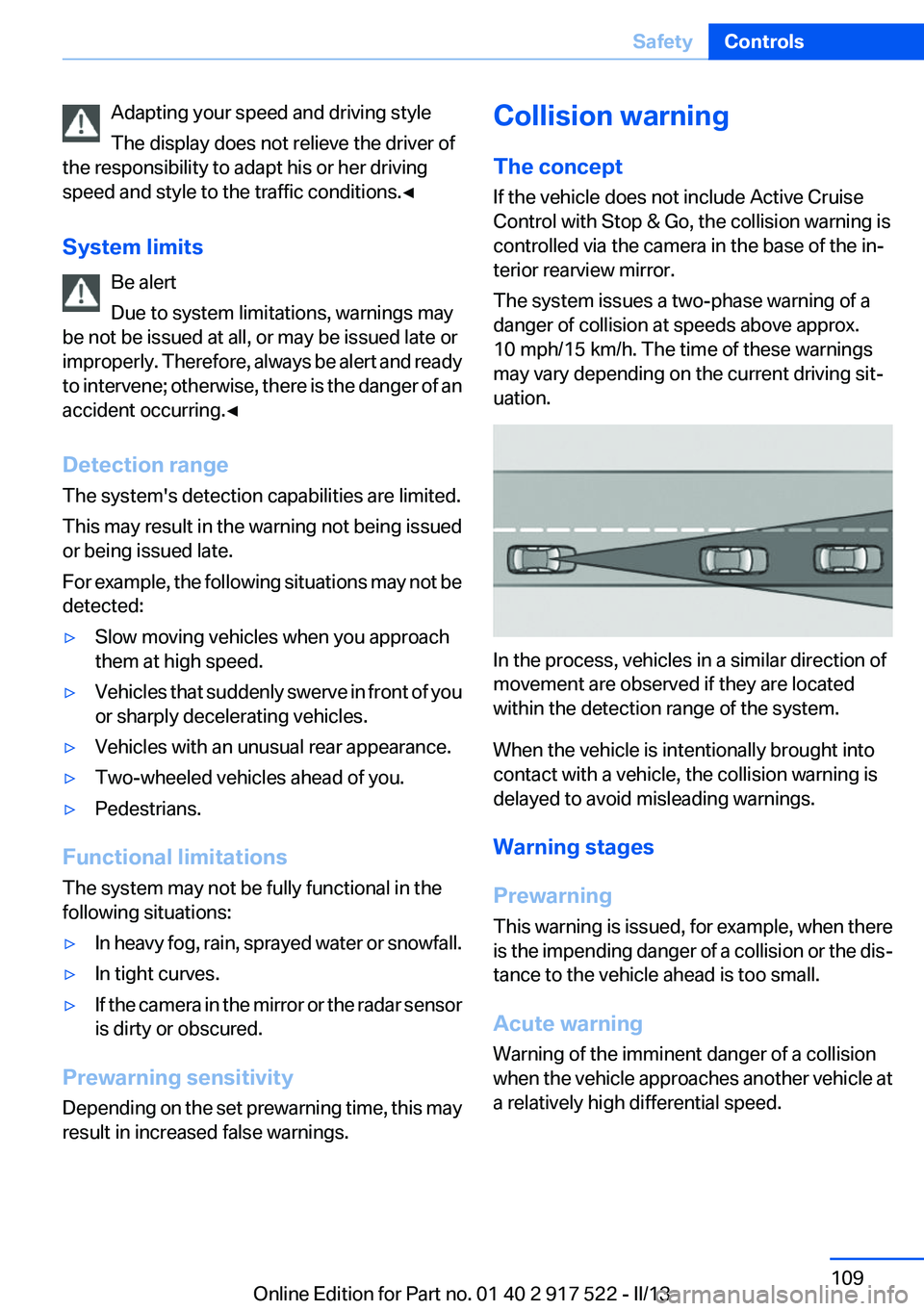
Adapting your speed and driving style
The display does not relieve the driver of
the responsibility to adapt his or her driving
speed and style to the traffic conditions.‚óÄ
System limits Be alert
Due to system limitations, warnings may
be not be issued at all, or may be issued late or
improperly. Therefore, always be alert and ready
to intervene; otherwise, there is the danger of an
accident occurring.‚óÄ
Detection range
The system's detection capabilities are limited.
This may result in the warning not being issued
or being issued late.
For example, the following situations may not be
detected:‚Ė∑Slow moving vehicles when you approach
them at high speed.‚Ė∑Vehicles that suddenly swerve in front of you
or sharply decelerating vehicles.‚Ė∑Vehicles with an unusual rear appearance.‚Ė∑Two-wheeled vehicles ahead of you.‚Ė∑Pedestrians.
Functional limitations
The system may not be fully functional in the
following situations:
‚Ė∑In heavy fog, rain, sprayed water or snowfall.‚Ė∑In tight curves.‚Ė∑If the camera in the mirror or the radar sensor
is dirty or obscured.
Prewarning sensitivity
Depending on the set prewarning time, this may
result in increased false warnings.
Collision warning
The concept
If the vehicle does not include Active Cruise
Control with Stop & Go, the collision warning is
controlled via the camera in the base of the in‚Äź
terior rearview mirror.
The system issues a two-phase warning of a
danger of collision at speeds above approx.
10 mph/15 km/h. The time of these warnings
may vary depending on the current driving sit‚Äź
uation.
In the process, vehicles in a similar direction of
movement are observed if they are located
within the detection range of the system.
When the vehicle is intentionally brought into
contact with a vehicle, the collision warning is
delayed to avoid misleading warnings.
Warning stages
Prewarning
This warning is issued, for example, when there
is the impending danger of a collision or the dis‚Äź
tance to the vehicle ahead is too small.
Acute warning
Warning of the imminent danger of a collision
when the vehicle approaches another vehicle at
a relatively high differential speed.
Seite 109SafetyControls109
Online Edition for Part no. 01 40 2 917 522 - II/13
Page 119 of 246
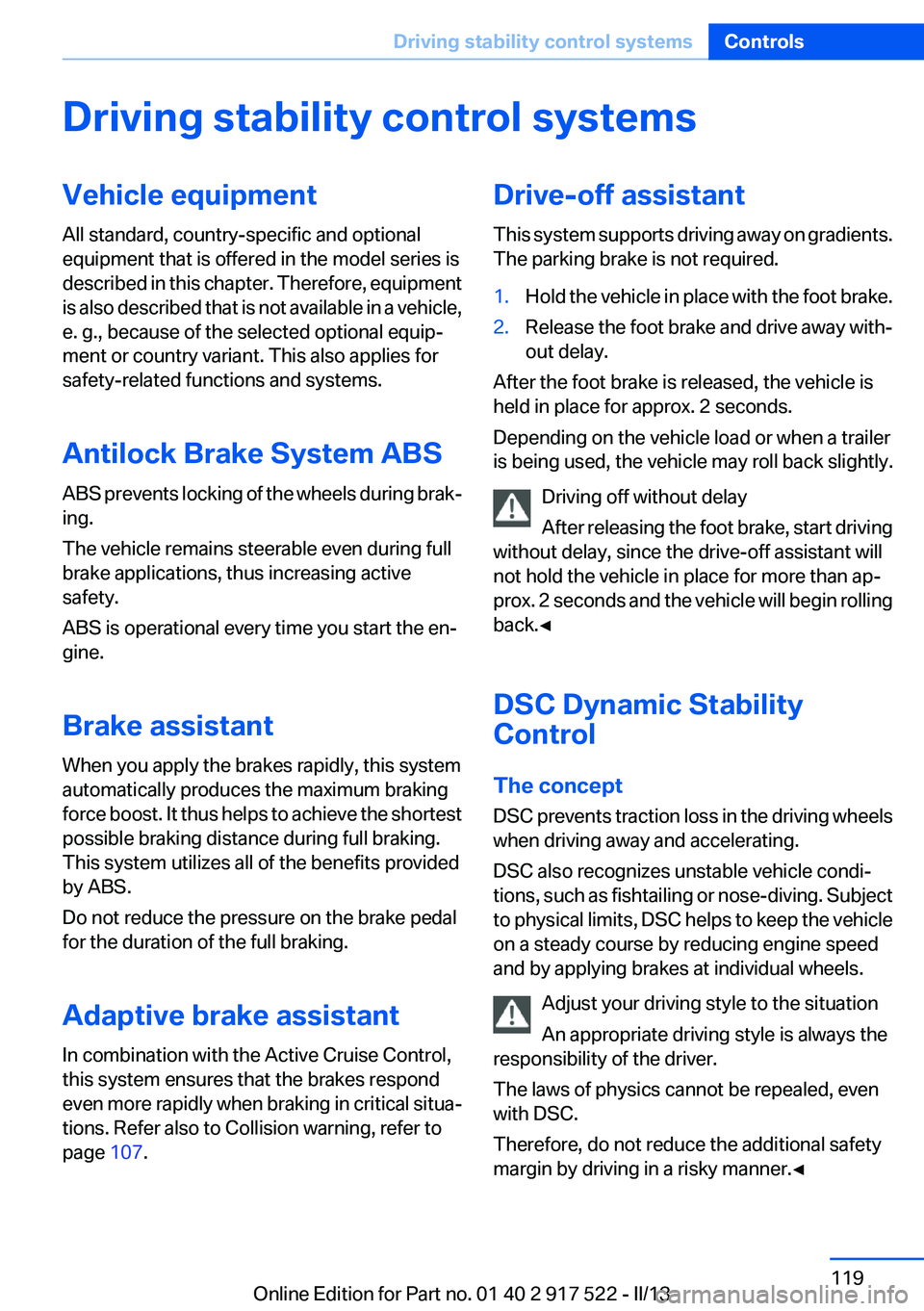
Driving stability control systemsVehicle equipment
All standard, country-specific and optional
equipment that is offered in the model series is
described in this chapter. Therefore, equipment
is also described that is not available in a vehicle,
e. g., because of the selected optional equip‚Äź
ment or country variant. This also applies for
safety-related functions and systems.
Antilock Brake System ABS
ABS prevents locking of the wheels during brak‚Äź
ing.
The vehicle remains steerable even during full
brake applications, thus increasing active
safety.
ABS is operational every time you start the en‚Äź
gine.
Brake assistant
When you apply the brakes rapidly, this system
automatically produces the maximum braking
force boost. It thus helps to achieve the shortest
possible braking distance during full braking.
This system utilizes all of the benefits provided
by ABS.
Do not reduce the pressure on the brake pedal
for the duration of the full braking.
Adaptive brake assistant
In combination with the Active Cruise Control,
this system ensures that the brakes respond
even more rapidly when braking in critical situa‚Äź
tions. Refer also to Collision warning, refer to
page 107.Drive-off assistant
This system supports driving away on gradients.
The parking brake is not required.1.Hold the vehicle in place with the foot brake.2.Release the foot brake and drive away with‚Äź
out delay.
After the foot brake is released, the vehicle is
held in place for approx. 2 seconds.
Depending on the vehicle load or when a trailer
is being used, the vehicle may roll back slightly.
Driving off without delay
After releasing the foot brake, start driving
without delay, since the drive-off assistant will
not hold the vehicle in place for more than ap‚Äź
prox. 2 seconds and the vehicle will begin rolling
back.‚óÄ
DSC Dynamic Stability
Control
The concept
DSC prevents traction loss in the driving wheels
when driving away and accelerating.
DSC also recognizes unstable vehicle condi‚Äź
tions, such as fishtailing or nose-diving. Subject
to physical limits, DSC helps to keep the vehicle
on a steady course by reducing engine speed
and by applying brakes at individual wheels.
Adjust your driving style to the situation
An appropriate driving style is always the
responsibility of the driver.
The laws of physics cannot be repealed, even
with DSC.
Therefore, do not reduce the additional safety
margin by driving in a risky manner.‚óÄ
Seite 119Driving stability control systemsControls119
Online Edition for Part no. 01 40 2 917 522 - II/13
Page 121 of 246
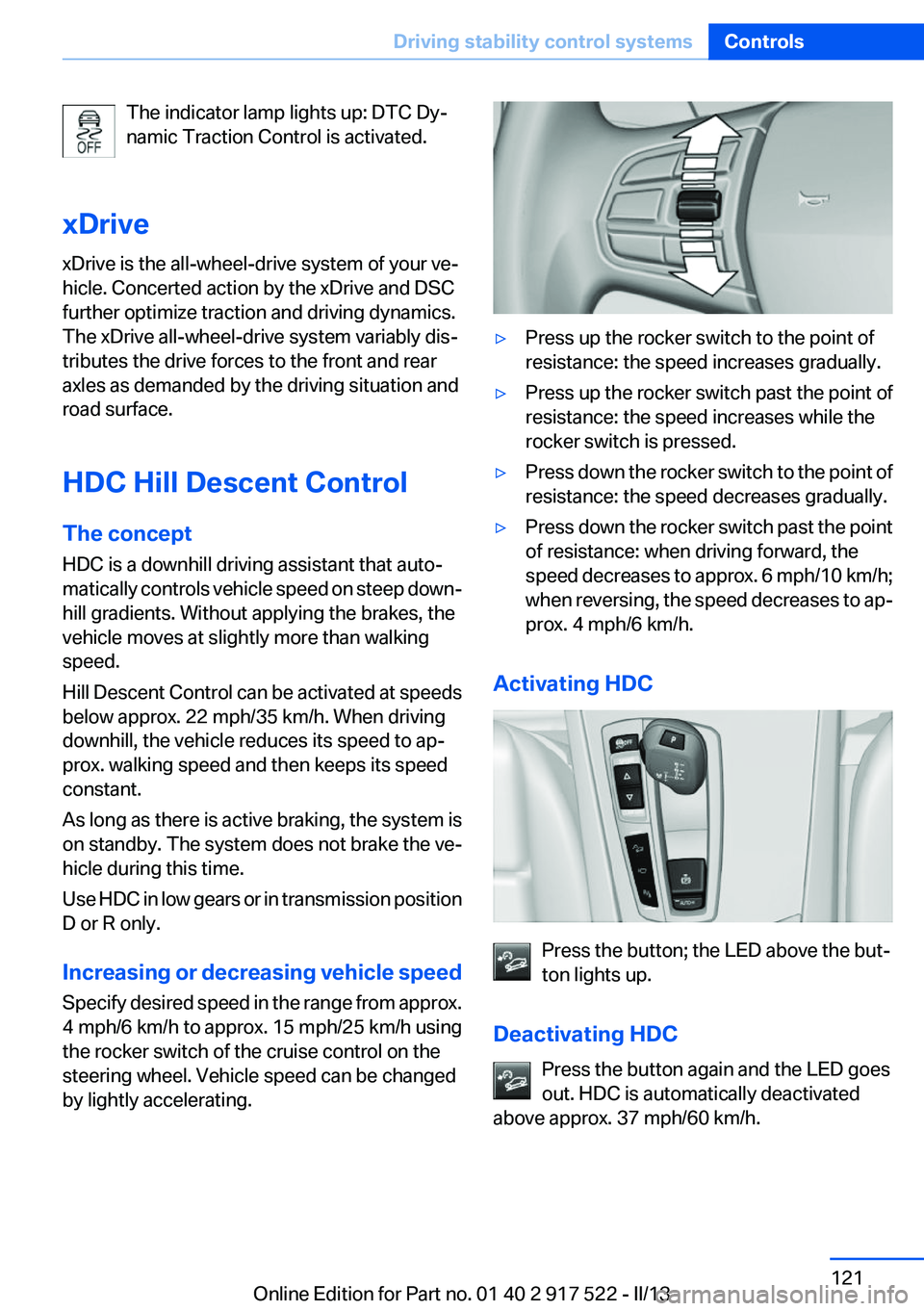
The indicator lamp lights up: DTC Dy‚Äź
namic Traction Control is activated.
xDrive
xDrive is the all-wheel-drive system of your ve‚Äź
hicle. Concerted action by the xDrive and DSC
further optimize traction and driving dynamics.
The xDrive all-wheel-drive system variably dis‚Äź
tributes the drive forces to the front and rear
axles as demanded by the driving situation and
road surface.
HDC Hill Descent Control
The concept
HDC is a downhill driving assistant that auto‚Äź
matically controls vehicle speed on steep down‚Äź
hill gradients. Without applying the brakes, the
vehicle moves at slightly more than walking
speed.
Hill Descent Control can be activated at speeds
below approx. 22 mph/35 km/h. When driving
downhill, the vehicle reduces its speed to ap‚Äź
prox. walking speed and then keeps its speed
constant.
As long as there is active braking, the system is
on standby. The system does not brake the ve‚Äź
hicle during this time.
Use HDC in low gears or in transmission position
D or R only.
Increasing or decreasing vehicle speed
Specify desired speed in the range from approx.
4 mph/6 km/h to approx. 15 mph/25 km/h using
the rocker switch of the cruise control on the
steering wheel. Vehicle speed can be changed
by lightly accelerating.‚Ė∑Press up the rocker switch to the point of
resistance: the speed increases gradually.‚Ė∑Press up the rocker switch past the point of
resistance: the speed increases while the
rocker switch is pressed.‚Ė∑Press down the rocker switch to the point of
resistance: the speed decreases gradually.‚Ė∑Press down the rocker switch past the point
of resistance: when driving forward, the
speed decreases to approx. 6 mph/10 km/h;
when reversing, the speed decreases to ap‚Äź
prox. 4 mph/6 km/h.
Activating HDC
Press the button; the LED above the but‚Äź
ton lights up.
Deactivating HDC Press the button again and the LED goes
out. HDC is automatically deactivated
above approx. 37 mph/60 km/h.
Seite 121Driving stability control systemsControls121
Online Edition for Part no. 01 40 2 917 522 - II/13
Page 124 of 246
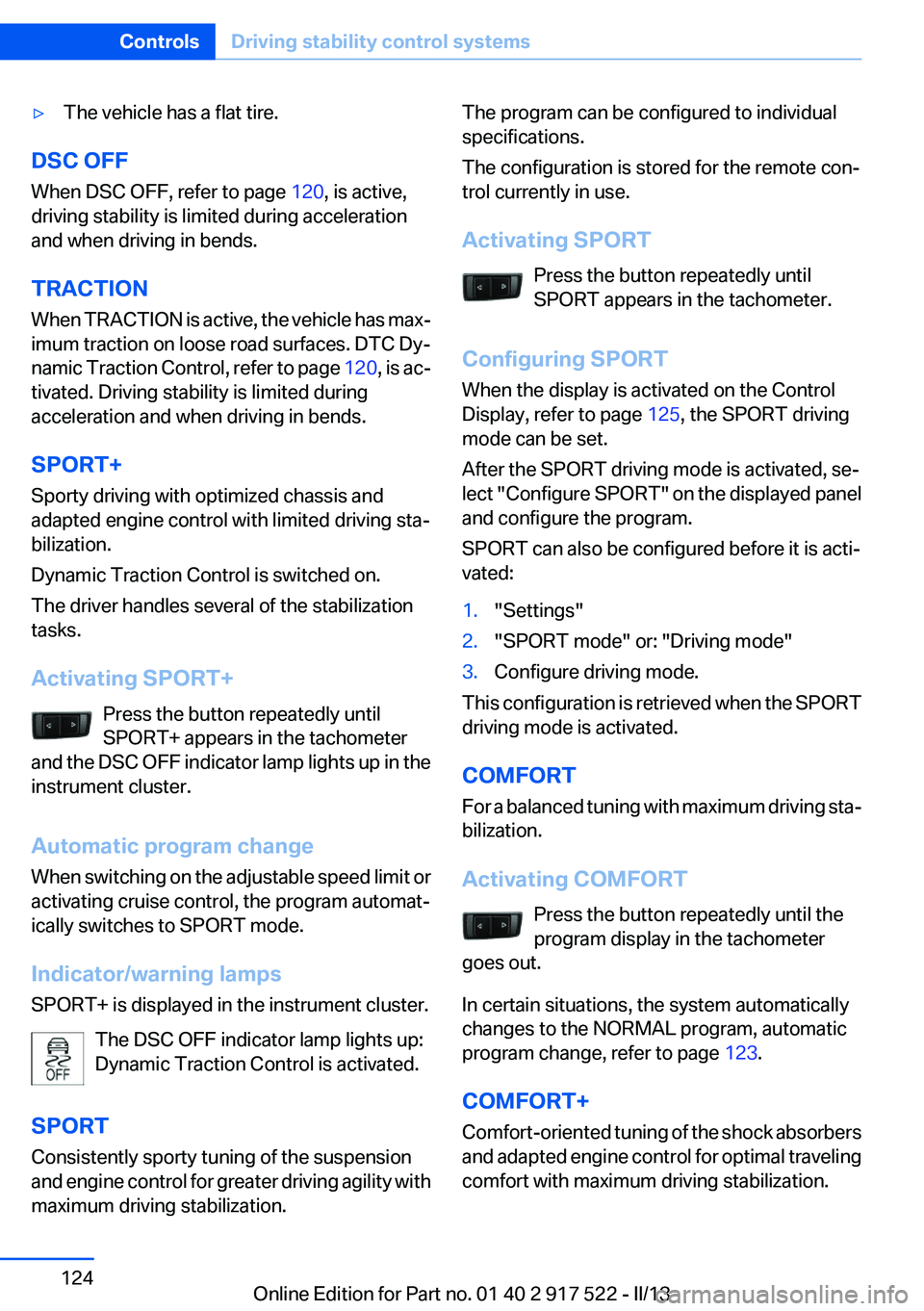
‚Ė∑The vehicle has a flat tire.
DSC OFF
When DSC OFF, refer to page 120, is active,
driving stability is limited during acceleration
and when driving in bends.
TRACTION
When TRACTION is active, the vehicle has max‚Äź
imum traction on loose road surfaces. DTC Dy‚Äź
namic Traction Control, refer to page 120, is ac‚Äź
tivated. Driving stability is limited during
acceleration and when driving in bends.
SPORT+
Sporty driving with optimized chassis and
adapted engine control with limited driving sta‚Äź
bilization.
Dynamic Traction Control is switched on.
The driver handles several of the stabilization
tasks.
Activating SPORT+ Press the button repeatedly until
SPORT+ appears in the tachometer
and the DSC OFF indicator lamp lights up in the
instrument cluster.
Automatic program change
When switching on the adjustable speed limit or
activating cruise control, the program automat‚Äź
ically switches to SPORT mode.
Indicator/warning lamps
SPORT+ is displayed in the instrument cluster.
The DSC OFF indicator lamp lights up:
Dynamic Traction Control is activated.
SPORT
Consistently sporty tuning of the suspension
and engine control for greater driving agility with
maximum driving stabilization.
The program can be configured to individual
specifications.
The configuration is stored for the remote con‚Äź
trol currently in use.
Activating SPORT Press the button repeatedly until
SPORT appears in the tachometer.
Configuring SPORT
When the display is activated on the Control
Display, refer to page 125, the SPORT driving
mode can be set.
After the SPORT driving mode is activated, se‚Äź
lect "Configure SPORT" on the displayed panel
and configure the program.
SPORT can also be configured before it is acti‚Äź
vated:1."Settings"2."SPORT mode" or: "Driving mode"3.Configure driving mode.
This configuration is retrieved when the SPORT
driving mode is activated.
COMFORT
For a balanced tuning with maximum driving sta‚Äź
bilization.
Activating COMFORT Press the button repeatedly until the
program display in the tachometer
goes out.
In certain situations, the system automatically
changes to the NORMAL program, automatic
program change, refer to page 123.
COMFORT+
Comfort-oriented tuning of the shock absorbers
and adapted engine control for optimal traveling
comfort with maximum driving stabilization.
Seite 124ControlsDriving stability control systems124
Online Edition for Part no. 01 40 2 917 522 - II/13
Page 126 of 246
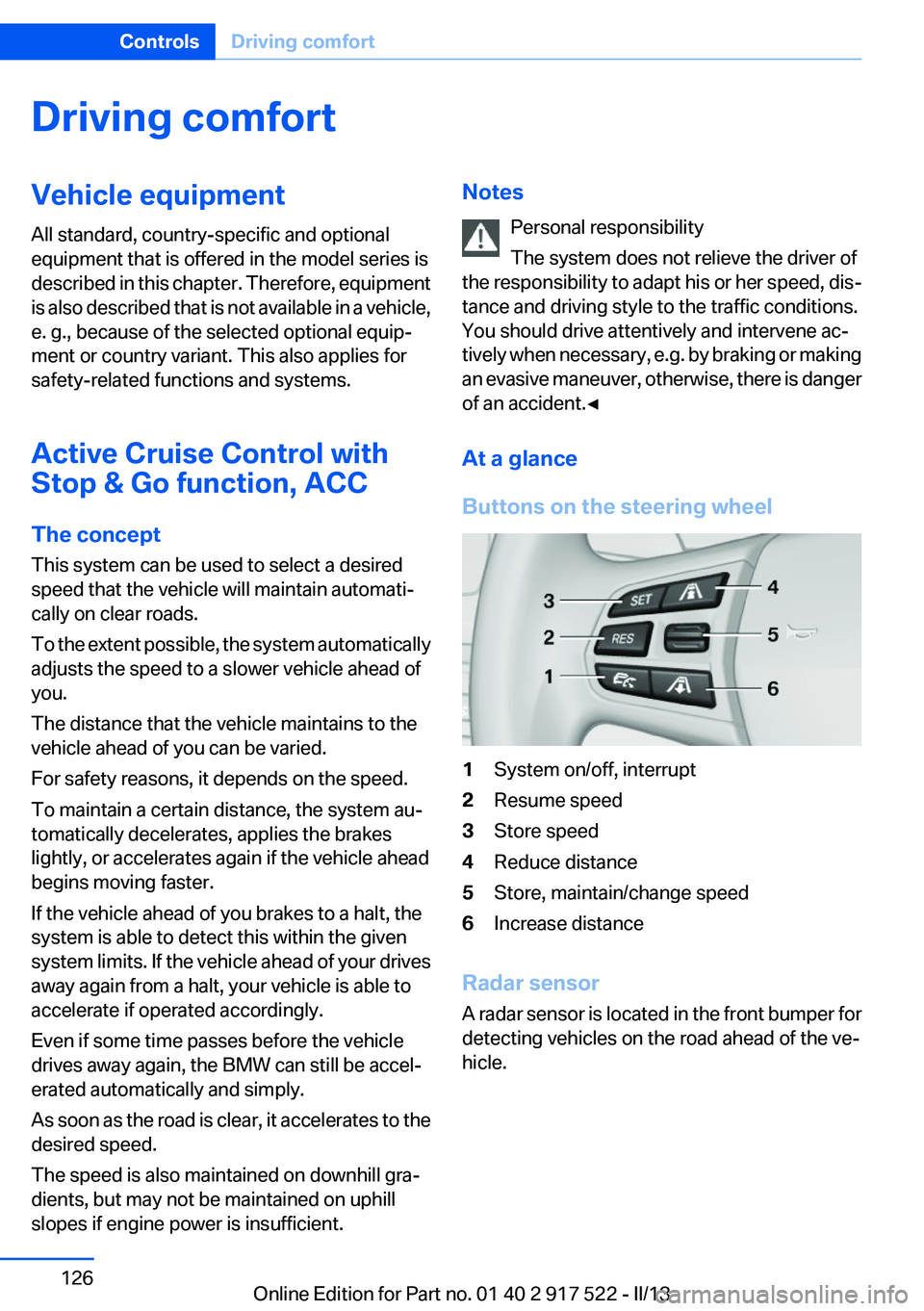
Driving comfortVehicle equipment
All standard, country-specific and optional
equipment that is offered in the model series is
described in this chapter. Therefore, equipment
is also described that is not available in a vehicle,
e. g., because of the selected optional equip‚Äź
ment or country variant. This also applies for
safety-related functions and systems.
Active Cruise Control with
Stop & Go function, ACC
The concept
This system can be used to select a desired
speed that the vehicle will maintain automati‚Äź
cally on clear roads.
To the extent possible, the system automatically
adjusts the speed to a slower vehicle ahead of
you.
The distance that the vehicle maintains to the
vehicle ahead of you can be varied.
For safety reasons, it depends on the speed.
To maintain a certain distance, the system au‚Äź
tomatically decelerates, applies the brakes
lightly, or accelerates again if the vehicle ahead
begins moving faster.
If the vehicle ahead of you brakes to a halt, the
system is able to detect this within the given
system limits. If the vehicle ahead of your drives
away again from a halt, your vehicle is able to
accelerate if operated accordingly.
Even if some time passes before the vehicle
drives away again, the BMW can still be accel‚Äź
erated automatically and simply.
As soon as the road is clear, it accelerates to the
desired speed.
The speed is also maintained on downhill gra‚Äź
dients, but may not be maintained on uphill
slopes if engine power is insufficient.Notes
Personal responsibility
The system does not relieve the driver of
the responsibility to adapt his or her speed, dis‚Äź
tance and driving style to the traffic conditions.
You should drive attentively and intervene ac‚Äź
tively when necessary, e.g. by braking or making
an evasive maneuver, otherwise, there is danger
of an accident.‚óÄ
At a glance
Buttons on the steering wheel1System on/off, interrupt2Resume speed3Store speed4Reduce distance5Store, maintain/change speed6Increase distance
Radar sensor
A radar sensor is located in the front bumper for
detecting vehicles on the road ahead of the ve‚Äź
hicle.
Seite 126ControlsDriving comfort126
Online Edition for Part no. 01 40 2 917 522 - II/13
Page 127 of 246
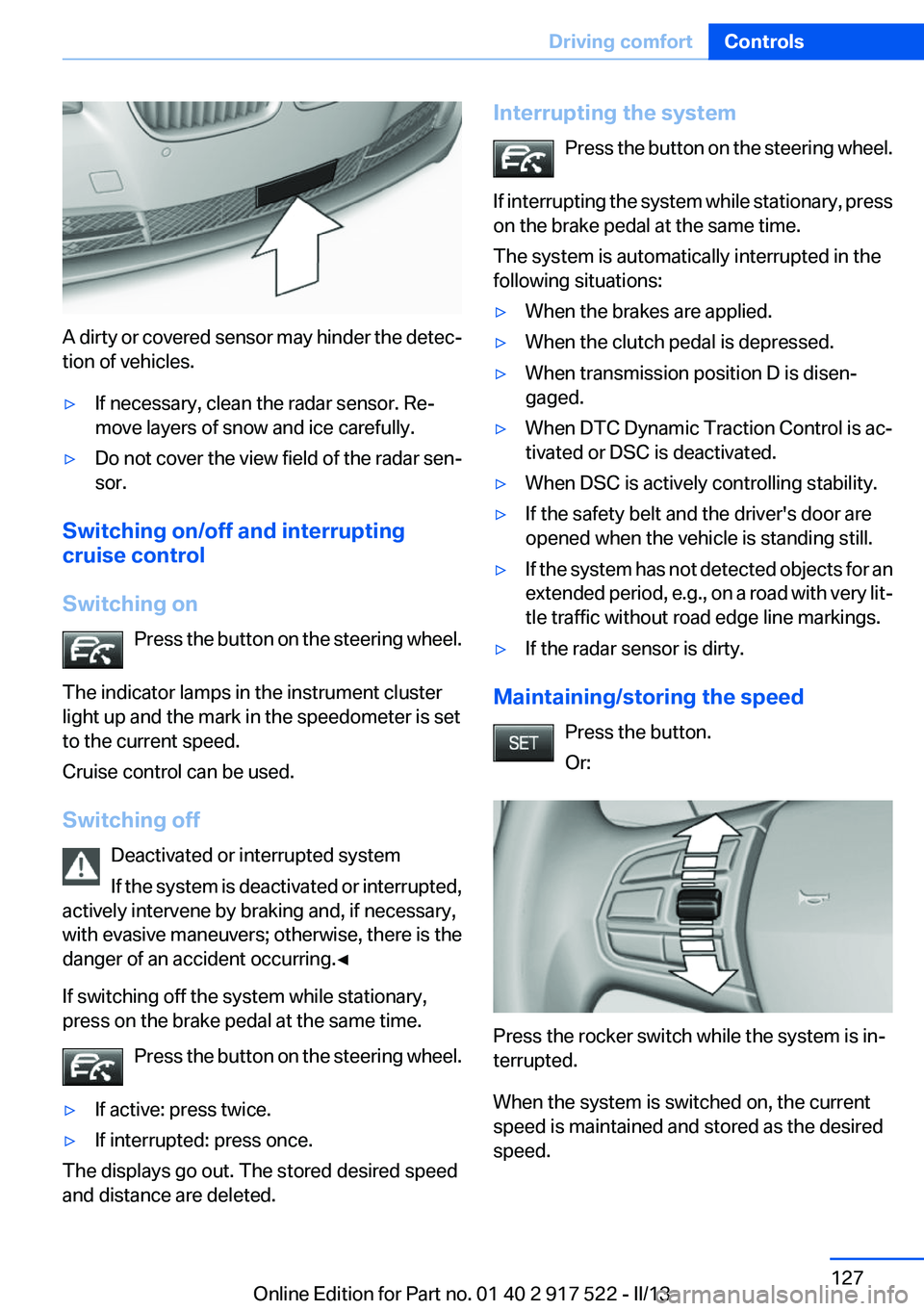
A dirty or covered sensor may hinder the detec‚Äź
tion of vehicles.
‚Ė∑If necessary, clean the radar sensor. Re‚Äź
move layers of snow and ice carefully.‚Ė∑Do not cover the view field of the radar sen‚Äź
sor.
Switching on/off and interrupting
cruise control
Switching on Press the button on the steering wheel.
The indicator lamps in the instrument cluster
light up and the mark in the speedometer is set
to the current speed.
Cruise control can be used.
Switching off Deactivated or interrupted system
If the system is deactivated or interrupted,
actively intervene by braking and, if necessary,
with evasive maneuvers; otherwise, there is the
danger of an accident occurring.‚óÄ
If switching off the system while stationary,
press on the brake pedal at the same time.
Press the button on the steering wheel.
‚Ė∑If active: press twice.‚Ė∑If interrupted: press once.
The displays go out. The stored desired speed
and distance are deleted.
Interrupting the system
Press the button on the steering wheel.
If interrupting the system while stationary, press
on the brake pedal at the same time.
The system is automatically interrupted in the
following situations:‚Ė∑When the brakes are applied.‚Ė∑When the clutch pedal is depressed.‚Ė∑When transmission position D is disen‚Äź
gaged.‚Ė∑When DTC Dynamic Traction Control is ac‚Äź
tivated or DSC is deactivated.‚Ė∑When DSC is actively controlling stability.‚Ė∑If the safety belt and the driver's door are
opened when the vehicle is standing still.‚Ė∑If the system has not detected objects for an
extended period, e.g., on a road with very lit‚Äź
tle traffic without road edge line markings.‚Ė∑If the radar sensor is dirty.
Maintaining/storing the speed
Press the button.
Or:
Press the rocker switch while the system is in‚Äź
terrupted.
When the system is switched on, the current
speed is maintained and stored as the desired
speed.
Seite 127Driving comfortControls127
Online Edition for Part no. 01 40 2 917 522 - II/13